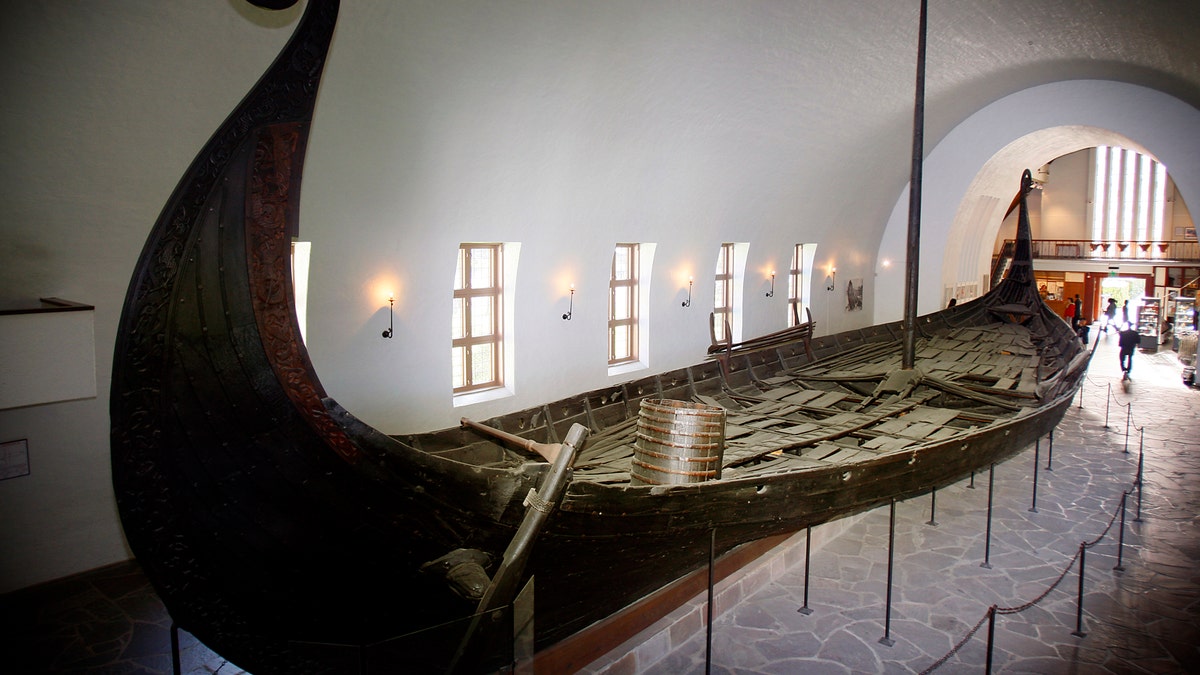
File photo - A longboat, known as the Oseberg ship, is seen on display at the Viking Ship Museum in Oslo Sept. 11, 2007. (REUTERS/Heiko Junge/Scanpix Norway)
For all their infamous raiding and plundering, the Vikings who attacked from Scandinavia might have been just a bunch of lonely-hearted bachelors, new research suggests.
During the Viking Age, which archaeological discoveries and written texts suggested lasted from about A.D. 750 to 1050, shipborne crews from Scandinavia went "viking" — that is, they started raiding. However, the causes of these invasions remain uncertain.
Previous research suggested a wide range of potential triggers for the Viking Age. One scenario hinted that warm climates led to better harvests and thus larger populations, and that such big groups felt compelled to raid. Another cited innovations in sailing technology, such as the additions of keels and sails to Scandinavian longships. [Fierce Fighters: 7 Secrets of Viking Culture]
However, scientists have argued that such explanations are not especially convincing because they raised questions as to why Scandinavians did not respond in other ways to such triggers. For example, if the trigger for the raids was "innovations in sailing technology, why did Scandinavians elect to go raiding rather than focusing their efforts on peaceful trade?" said senior study author Mark Collard, a biological anthropologist at Simon Fraser University in Burnaby, British Columbia.
More from LiveScience
Now, researchers suggest a new twist on an ancient explanation: Scandinavian practices that led powerful men to monopolize women also might have led to significant pools of unwed men. Many of these single men, looking for marriage, might have gone on raids to gain status, wealth and captives, and thus go on to secure brides and concubines of their own.
Looking for love
The idea that an excess of single young men led to Viking raiding is one of the oldest explanations for the Viking Age, put forward about 1,000 years ago by historian Dudo of St. Quentin in his tome "History of the Normans."
"We were able to reinvigorate an explanation for Viking raiding that has been around for nearly 1,000 years," Collard told Live Science.
The new model links this older idea with the customs of polygyny, or having multiple wives, and concubinage, or the keeping of concubines, that ancient texts such as the "Sagas of Icelanders," medieval German chronicles, and reports by travelers such as the 10th-century Arab envoy Ahmad Ibn Fadln suggested that Scandinavians once practiced, the researchers said.
Polygyny and concubinage would have limited the number of women eligible for single men to marry. Evolutionary biology suggests that such an imbalance would have then boosted competition for mates among unmarried men. Indeed, prior work has suggested that, on average, men die in warfare more often in polygynous societies than in monogamous ones, the researchers said.
This resulted in volatile societies in Scandinavia in which men were moved to engage in risky behavior, such as raiding expeditions to gain wealth and status to attract brides and to secure female slaves. One consequence of this was a surge in raiding that is linked with the start of the Viking Age, the researchers suggested.
Viking bachelors
Archaeological Viking finds discoveries and historical records suggest that loot and captives were main targets of raiders, and that most Vikings were men, although there is evidence that some raiders may have been women. For instance, the Irish text "War of the Gaedhil with the Gaill" recorded that one fleet belonged to a woman dubbed the Inghen Ruaidh, or "Red Girl," in Ireland during the 10th century A.D., the researchers said. [Photos: 10th-Century Viking Tomb Unearthed in Denmark]
This model suggests that most Viking raiders would have been young men. Ancient mass graves and Icelandic sagas support this explanation, the researchers said. Other possibilities the model presents include that the Vikings were hypersensitive to insults, that they viewed risk taking positively and that there was intense competition among men. Icelandic sagas also revealed that these characteristics were common in Viking societies, the scientists added.
"I'd like people to keep in mind that the Vikings weren't particularly unusual in engaging in concubinage and polygyny or in going raiding," Collard said. "Plenty of societies in the past approved of polygynous relationships — indeed, some still do in the present day. Similarly, raiding was not unusual in the past and remains fairly common today in certain places. So, while the Vikings can seem exotic, it's a mistake to view them that way. They weren't outliers when it comes to human behavior."
Men of low status might not have been the only members of Viking cultures seeking to go on raids. Powerful men would likely want to support, fund and lead raids to acquire plunder, in order to develop and keep their reputations and further their ambitions, the researchers said.
"We're not saying that every Viking went raiding," Collard said. "Many did; others didn't. Social life in the Viking Age would have been as complicated as social life in the present day."
It remains uncertain why Viking raids began when they did. The researchers suggested that one trigger of this raiding "might have been an influx of Abbasid coinage into eastern Scandinavia via Russian and Baltic trade routes in the last decades of the eighth century [A.D.]," Collard said. "That's plausible, because it likely would have increased the amount of inequality and, therefore, the level of competition among men. But I'm sure there are other potential proximate triggers that we haven't considered."
The scientists detailed their findings online Oct. 30 the journal Evolution and Human Behavior.
Original article on Live Science.